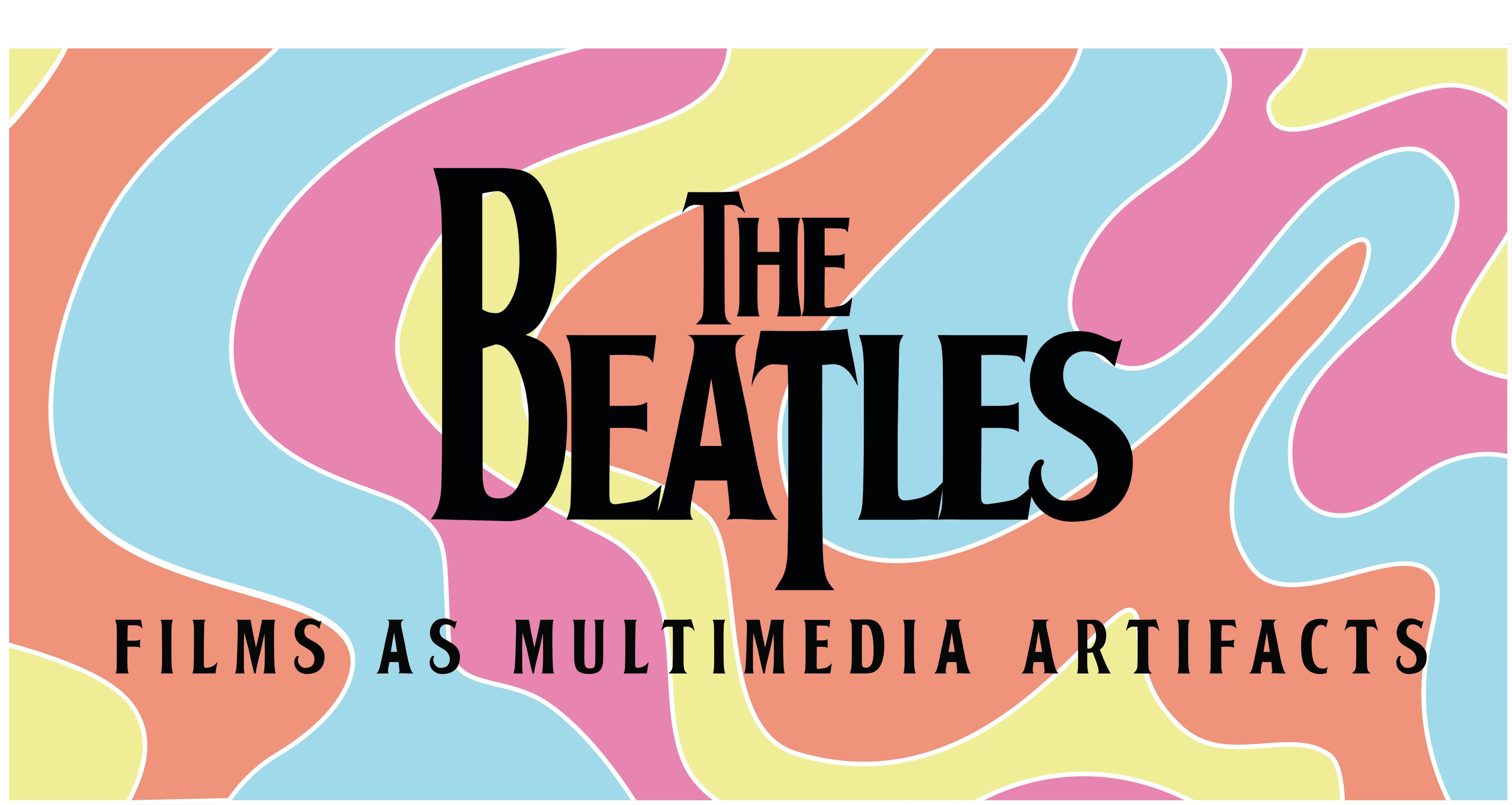
By Anna Shura | November 21, 2022
General Introduction
The Beatles, John Lennon, Paul McCartney, George Harrison, and Ringo Starr, are often referenced as pioneers and cultural icons in the music industry and modern history. Despite their enormous popularity and continuous legacy fifty-two years after disbanding, they were not an overnight success spending several years playing in cramped clubs in Liverpool, England and Hamburg Germany.
When they landed a deal with producer George Martin and EMI Records in 1962, the band recorded their first album in a single day, and Please, Please, Me quickly rose to popularity across the UK upon release in 1963. One year later, the Beatles had a number one in America, “I Want To Hold Your Hand,” and their arrival in New York and appearance on the Ed Sullivan show quickly launched global Beatlemania, a term which refers the crazed fan culture surrounding the Beatles.
Naturally, the fans of the Beatles worldwide wanted anything and everything Beatles related, and the Beatles also shared an interest in creative endeavors beyond their albums. While music was the basis for their projects across 1960 to 1970, films were an opportunity for a global audience to enjoy the band and to push the creativity of the Beatles. The Beatles’ involvement in the films range from unexperienced actors to drugged creators to writers and directors, and the public reaction to the films also varies widely with the influence of the time period and platform of the release.
Three live-action films were made featuring the Beatles playing scripted versions of themselves. In the following report, the Beatles films, A Hard Day’s Night, Help!, and Magical Mystery Tour, are analyzed as multimedia artifacts through their audio, visual, and textual components. Additionally, the creative process and the historical and present-day context of the films are considered.
A Hard Day's Night
A Hard Day’s Night is the Beatles’ debut film released on July 6th, 1964, directed by Dick Lester and starred the Beatles and Wilfrid Brambell as Paul’s grandfather. The premise of the film follows the Beatles’ lifestyle in their intense early stardom.
A day in the life of a Beatle was “a hard day’s night,” to quote Ringo, between running away from swarms of fans, jumping on trains to travel between gigs, answering fan mail in hotels, getting mobbed at press conferences, rehearsing and for working television programs, and churning out music wherever they went.
From a public reception perspective, the film premiered in London, Liverpool, and New York, and the world devoured the chance to attend a Beatles’ concert in their local cinema. The film was a stylistic departure; no one had ever seen such playful and unique coverage of a musical group in a movie.
The film was initially produced as a cheap capitalization on a fading success story, but the Beatles’ success continued to blossom throughout the filming. A Hard Day’s Night was a popular and critical success upon release and remains well-respected in present day. A Hard Day’s Night sports a current 98% on Rotten Tomatoes, two Academy Award nominations, and numerous appearances on top film lists from Robert Ebert’s personal rankings to Time magazine’s best 100 films.
Help!
Help!, the Beatles’ second Dick Lester film released in 1965 closely follows A Hard Day’s Night. Even with one year between the films and reoccurring actors, however, the attitude of Help! and A Hard Day’s Night is very different.
Rather than a mockumentary format, Help! is a musical comedy adventure film and features a satirical James Bond-like style. The plot moves beyond the Beatles’ lives to feature a cult sacrifice storyline across multiple locations around the world. Unfortunately, Ringo has mysteriously obtained the ring to be worn by the sacrifice victim, and the band must escape the pursuits of the cult whilst trying to free Ringo from the ring.
The response to Help! was not as euphoric as its film predecessor. Beatlemania’s landscape changed remarkably quickly, and the influence of audience expectations verses the personal interests of the band members is evident in the dissatisfied responses to Help!. Britain’s most popular newspaper at the time, The Daily Mirror, scathingly complimented the physical appearances of the Beatles and determined they were “redundant” and the film was “dull.”
The main criticisms stem from direct comparison to A Hard Day’s Night. Just a year after the first film, the Beatles were awarded considerably less input during the making of Help! and were just beginning their relationship with drugs. John Lennon described the changes in David Sheff's book, All We Are Saying: The Last Major Interview with John Lennon and Yoko Ono, “we were smoking marijuana for breakfast during that period. Nobody could communicate with us, it was all glazed eyes and giggling all the time. …It's like doing nothing most of the time, but still having to rise at 7 am, so we became bored.”
Still, the film is not a failure by any critical means given the loyalty of the band’s fanbase both in theatres in 1966 as well as the modern-day stylistic appreciation of Help!. The film is now cited as a major influence on the pop art style of the Batman television series and the plot design of Monty Python.
Magical Mystery Tour
Magical Mystery Tour is the most self-made of the Beatles films as the four band members served as the writers, directors, composers, and stars. Released in 1967, the soundtrack was only a double EP in the UK but served as an album between Sgt. Pepper’s Lonely Heart’s Club Band and “The White Album” elsewhere.
The premise of the film draws from the tradition of coach trips from Liverpool, England. During Magical Mystery Tour, an odd cast of characters, including the Beatles, adventure on a psychedelic bus mostly for the purpose of taking a trip itself.
The film was released to the public on BBC1 on Boxing Day, December 26th, 1967 in black and white despite being shot in color. While audiences greatly enjoyed the soundtrack, critics and public alike were deeply unimpressed by the film. Thousands of complaints were apparently sent into the BBC. Paul McCartney, the leading creator on the project, has spent decades both apologizing for and defending the film beginning the day after the release when he appeared on David Frost’s show as “the man most responsible."
While Magical Mystery Tour is the least popular out of the trio of Beatles live-action films, the Beatles agree it was not as much of a mess as the initial reviews reported. Magical Mystery Tour maintains a strong position in film history as it reflects both the cinematic influences on the Beatles and emerging surrealist styles of the late 60s film scene.
Once again, the Beatles' third live-action film serves as a major point of inspiration for Monty Python with its quirky humor. The film also captures several important music videos with the unique projector styling of “Blue Jay Way” and the iconic musical and visual oddity that is “I Am the Walrus”.


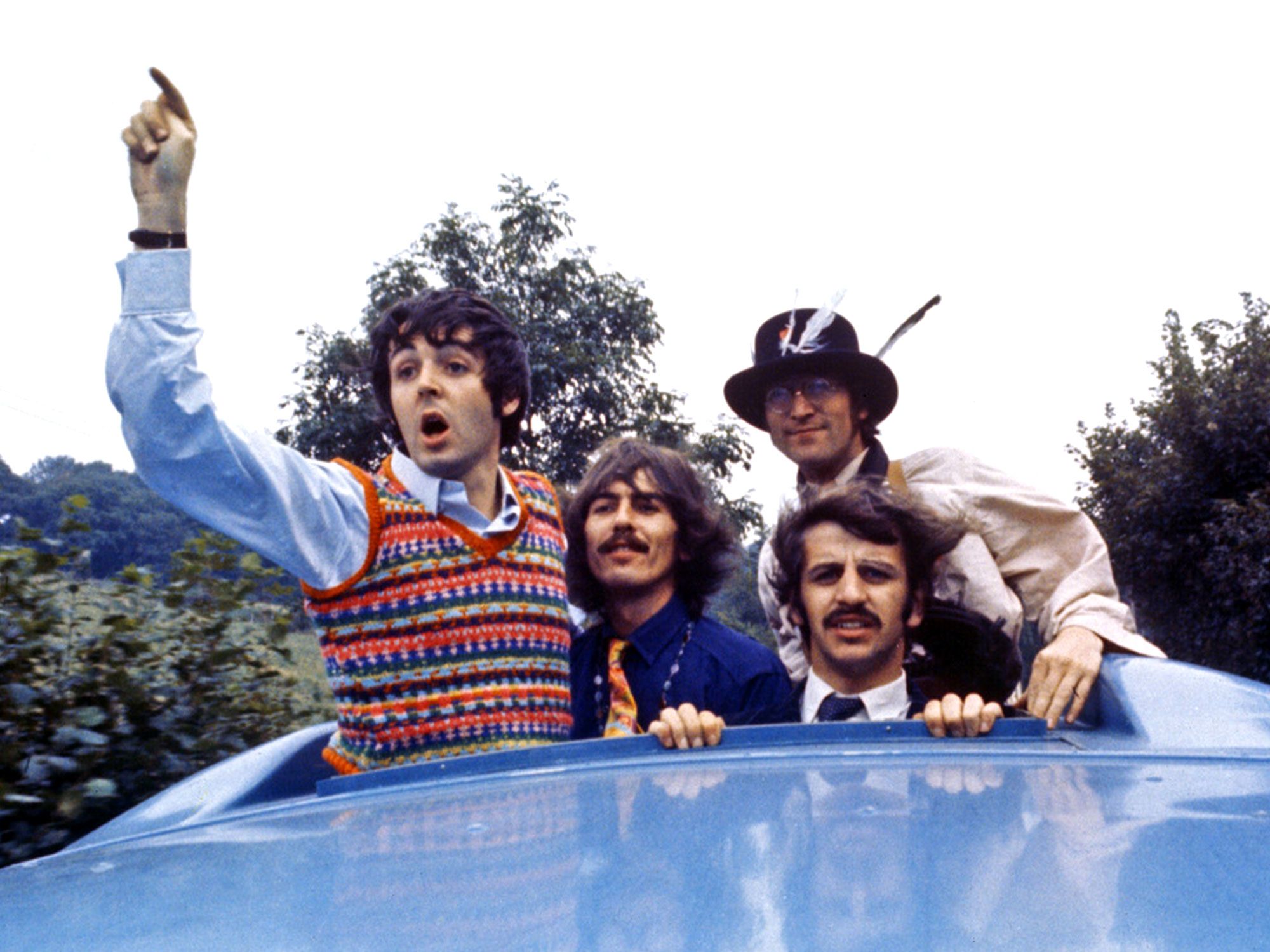
Musical Foundation
The Beatles are first and foremost an iconic band, and therefore, their films are based in their music. Soundtracks naturally contribute to the overall tone and experience of a film as a supporting act to the story and a pathos appeal to the audience.
In considering the audio, visual, and textual multimedia elements of the Beatles’ films, the music of the Beatles serves as the foundational element. The music of the films will be analyzed as a soundtrack to the visual imagery before considering the recorded performances of the Beatles singing along to their songs.
Pure Soundtrack
While the Beatles films commonly present music video-like moments, music also aids the films in as a traditional soundtrack. Therefore, “pure soundtrack” music, in which the Beatles are not shown singing, is an important form of audio and visual multimedia, and the following soundtrack songs serve as points of analysis across the films: A Hard Day’s Night’s “Can’t Buy Me Love,” Help!’s “In the Tyrol,” and Magical Mystery Tour’s “Flying.”
Can't Buy Me Love
In A Hard Day’s Night, the boys look for an escape from the demands of television program rehearsals and overbearing managers. They break loose from the studio and frolic in a nearby field accompanied by the song, “Can’t Buy Me Love." With helicopter shots of leapfrog, ground level camera angles, and a handheld shot of the Beatles playing games, a visual story of schoolboys at recess is insinuated.
“Can’t Buy Me Love” is a swinging song, and its energy matches and accentuates the activities of the Beatles. It would be strange if the soundtrack was one of the Beatles’ slower, heart-felt numbers given the youthful freedom expressed in the clips of the Beatles jumping around. The classic Beatle scream and jazzy guitar riffs confirm the upbeat chaos of the Beatles escaping from their responsibilities with the soundtrack of “Can’t Buy Me Love”.
In the Tyrol
Unlike the other Beatles films, Help! had an additional soundtrack to supplement the Beatles’ album Help!. Film score composer Ken Thorne was hired, and his work on Help! was nominated for the 1965 Grammy Nominated Best Original Score for a Motion Picture or Television. The soundtrack features the James Bond theme, Indian inspired sitar music, instrumental versions of Beatles’ songs, classical music, and original scores to accompany the chaotic events of the film.
The soundtrack piece “In the Tyrol” is an instrumental piece orchestrated by Ken Thorne for the film and is played behind the cult chasing the Beatles in their home. “In the Tyrol” opens with a quirky sounding march in minor which matches the goonish cult members hiding on screen.
However, the piece then cuts to Richard Wagner’s classical composition “Lohengrin: Prelude to Act III” recorded as a full orchestra with the strings moving at a quick pace ahead of the descending brass as the cult members break into the Beatles’ house and battle the band members.
As “Lonhengrin: Prelude to Act III” concludes, the minor march of the cult members returns. The effect of the arrangement is the introduction of the cult members engaging the Beatles in a game of cat and mouse as the band members try to elude the numerous attempts to capture Ringo.
While the name of the piece refers to a mountainous region between Austria and Italy where the Beatles filmed their snow scenes for the film, the piece is played over the chase scene between the Beatles and the cult in the band’s home. As a multimedia artifact, the chasing effect of the instrumental soundtrack music compliments the Beatles chaotic encounters and does not require them to be singing along to their songs.
Flying
“Flying” is a rare example of an instrumental Beatles’ song. Even stranger is the fact the Magical Mystery Tour song accompanies a several minute long shot of landscapes without any interruption of the Beatles’ faces or other characters.
Interestingly, the landscape shots are recolored left-over footage from Dr. Strangelove passed to the Beatles thanks to the editorial team’s connections. While the Beatles were film making armatures, using scraps from contemporary projects, the Beatles were also employing inspiration from other artists in Magical Mystery Tour.
During the late 60s, Paul McCartney had been experimenting with making short films for some time while also consuming a variety of art from Orson Welles to Andy Warhol. The Dr. Strangelove footage is recolored to display an unnatural world, and the lack of Beatles’ imagery or traditional music forces the audience to take in the view outside the bus as if they were traveling on the tour themselves. Therefore, the “Flying” scene as a multimedia example represents how music can shift the tone of a production and while drawing attention to an unusual visual component.
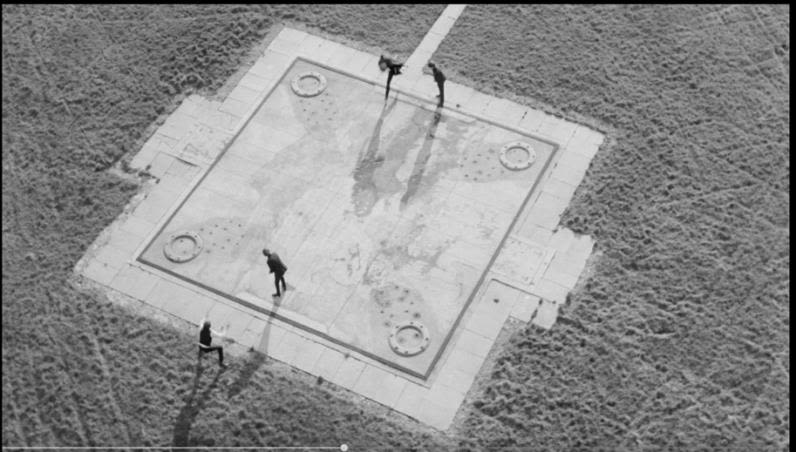
Helicopter shot of Beatles playing games during "Can't Buy Me Love" (38:01, A Hard Day's Night).
Helicopter shot of Beatles playing games during "Can't Buy Me Love" (38:01, A Hard Day's Night).
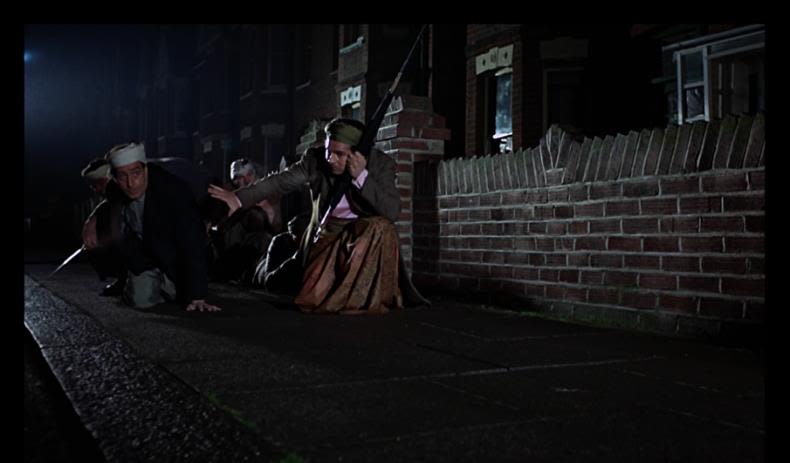
Cult members wait to invade the Beatles' house as “In the Tyrol” begins to play (33:27,Help!).
Cult members wait to invade the Beatles' house as “In the Tyrol” begins to play (33:27,Help!).
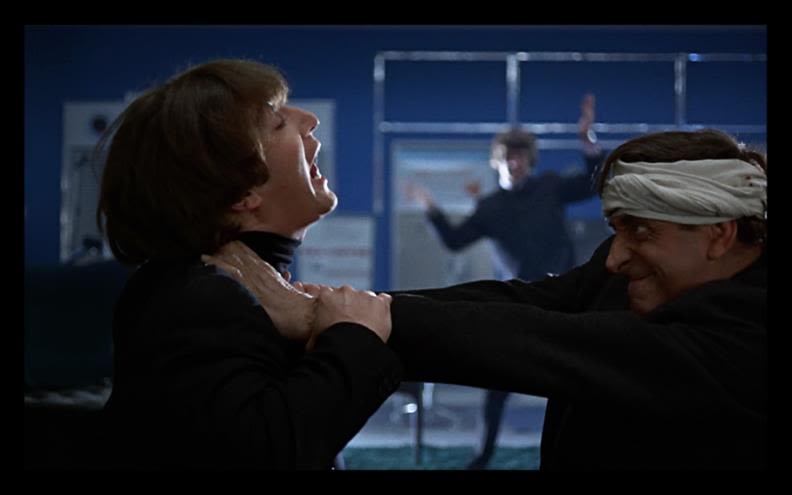
Cult member strangles John Lennon in the fight with the accompaniment of “In the Tyrol’s” chaotic arrangement of the “Lonhengrin: Prelude to Act III” (34:11, Help!).
Cult member strangles John Lennon in the fight with the accompaniment of “In the Tyrol’s” chaotic arrangement of the “Lonhengrin: Prelude to Act III” (34:11, Help!).
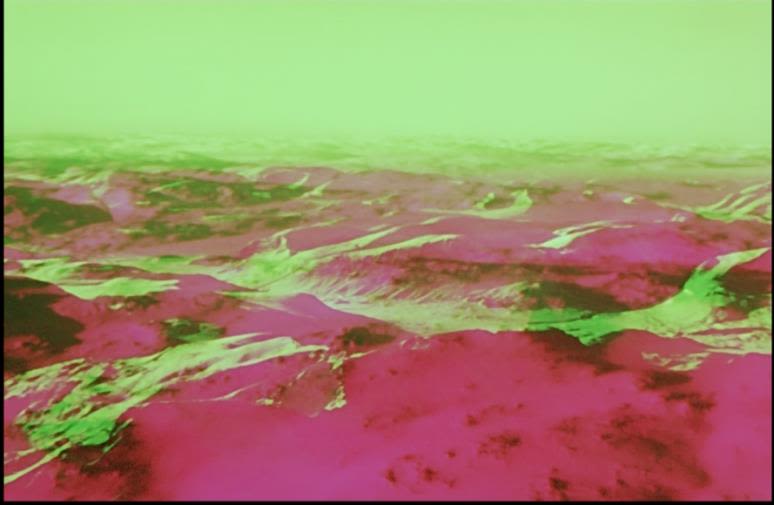
Recolored landscape shots from Dr. Strangelove outside the tour bus (18:54, Magical Mystery Tour).
Recolored landscape shots from Dr. Strangelove outside the tour bus (18:54, Magical Mystery Tour).
Music Videos
The Beatles were pioneers in making music videos in general, and their films were subsequently an opportunity for several visually recorded performances of their songs. Across the films, the Beatles’ sing and play along to their own music in a traditional concert setting, under colorful lighting in a film studio, and accompanied by strange characters and costumes.
The range of visual and stylistic choices are largely driven by the time period in which the films were released. While the films present a mix of imagined and realistic musical performances, the trio works to include the most relevant situations for the Beatles to play “I Should Have Known Better” on stage in A Hard Day’s Night, “You’re Going to Lose That Girl” in the recording studio in Help!, and “I am the Walrus” for a music video in Magical Mystery Tour.
("I Should Have Known Better" at 3:44)
I Should Have Known Better
At the end of A Hard Day’s Night, the Beatles give a concert to a full theatre on a fictional television program. Film recordings of the Beatles playing to audiences in the early 60s are somewhat of a rarity due to their manager Brian Epstein wanting to reduce pirated recordings. Therefore, the Beatles playing “I Should Have Known Better” with glances to the emotional reactions in the audience is a historical and relatively realistic recording.
Although the music is not live and instead prerecorded in a studio, the Beatles are clearly playing the song on their instruments. George enjoys a dance on his solo in reaction to the crowd, and the audience is shown Ringo’s view of the theatre from behind his bouncing head. The cinematography featured in this scene set the precedent for visual musical recordings to come with the focus on close ups and cut aways to the crowd. Ultimately, with the combination of the visual and audio recording both the immediate audience as well as the global cinema audience can forever attend a Beatles concert.
(Clip of "You're Going to Lose That Girl" performance in Help!)
You're Going to Lose That Girl
Out of the trio of films, Help! includes the most integrated musical performances allowing the Beatles to frequently break into song. However, the majority of these performances include shots of the Beatles messing around and instead of playing their instruments for the entirety of the song. Their performance of “You’re Going to Lose That Girl” is accompanied by the Beatles realistically playing in a recording studio, but the normalcy of the situation does not hinder Help!’s unique stylistic choices.
With close ups on the instruments and the facial features of the Beatles, Help! takes the revolutionary musical cinematography established in A Hard Day’s Night a step further. Colorful spotlights and moody shadowed lighting emphasize how the Beatles’ studio recordings were performances in themselves. The visual recording of “You’re Going to Lose That Girl” emphasizes the Beatles' musicianship as the audience gains an extreme close up view of the instrumental techniques of the band members and see the Beatles in their common workplace.
From a plot perspective, the recording studio performance adds a realistic detail to the otherwise highly satirical plot of Help!. The traditional studio serves as a point of comparison to the film’s later mock recording studio in a field surrounded by tanks for George Harrison’s “I Need You.”
"I Am the Walrus" Music Video
I Am the Walrus
Although the Beatles frequently engaged in pushing creative limits, the video component of “I Am the Walrus” filmed in Magical Mystery Tour continues to be a unique part of Beatles cinematic history. From their colorfully printed outfits to their animal costumes, the Beatles themselves are shown in an extreme contrast to their days in identical suits. As a song itself, “I Am the Walrus” describes several interesting characters including an Egg Man and policemen in a row, and the absurdity of the collection of characters is enforced by the visual component to the audio recording of the song.
Additionally, the Beatles’ unique instruments are introduced to the story of the song through the film. While the instruments can obviously be heard on the audio alone, the visual media reveals a red face replacing the traditional Beatles logo on Ringo’s Bass Drum, John sitting behind a white grand piano instead of his usual guitar, Paul not playing his classic Höfner bass, and George wielding his self-painted guitar “Rocky” covered in DayGlo and nail polish. Without the inclusion of the Beatles’ performance of “I Am the Walrus” in Magical Mystery Tour, the extent of unusual creativity encapsulated in both the song itself as well as the Beatles as creators in the late sixties could not be fully realized.
Words Behind the Scenes
Despite movies often being presented as an antithesis to the written word, most films rely on a script or an adaptation of other textual material to guide the plot. As the trio of films presents the Beatles’ songs throughout the plots, the lyrics are an obvious aspect of the multimedia artifacts.
As each of the movies is named with a title track off a Beatles’ album, the textual component of music in relation to the plot of the film must be discussed. Text has always been an important part of the Beatles’ story with their song writing abilities allowing them to stand out from other musicians at the time. Furthermore, text is relevant to the multimedia artifacts that are the Beatles films as the movies vary in possessing a classic screenplay or verses a reliance on unwritten improvisation.
Text of the Title Tracks
A Hard Day's Night
As previously mentioned, “a hard day’s night,” is a quote from Ringo who had a habit of saying malapropisms. Luckily, the Beatles also had a habit of paying attention to the possibilities of wordplay when writing songs.
Given the film’s mockumentary styling, Paul McCartney reflected in his recent book The Lyrics: 1956 to the Present, “the title is certainly a commentary on the craziness of our lives."
The sheer amount of events and travel and hours at work for the Beatles guides the film and obviously relates to the sentiment of “working like a dog." In fact, the title track of the film was written in only twenty-four hours.
When a title was needed for the film, John suggested Ringo’s quote to the producer, and while the name A Hard Day’s Night stuck, the producer requested a song to accompany the title. The next day, John and Paul presented the song “A Hard Day’s Night” demonstrating both the dynamic relationship between text, music, and the film as well as the talent of the Beatles as writers themselves.
A Hard Day’s Night has an Oscar nominated screenplay, and yet, the title song lyrics’ summarize the plot of the film which demonstrates the Beatles’ intimate relationship with their musical lyrics as a textual element of the multimedia film.
Help!
The song “Help!” sets the tone for the Bond-esq plot of the film, but the lyrics offer a more personal background than the visual multimedia portrays.
Given the extremes of the Beatles’ fame and their lack of involvement in the production process of the film, John Lennon quite literally wrote a cry for help as the title track of the album and second film. As a multimedia element of the film, the lyrics of “Help!” take on an imaginary role when the Beatles need help escaping from cults and scientists.
On its own, the text depicts a bleaker picture of the Beatles as “not so self-assured” and “feeling down." The context of the visual component of the film usurps the insecure sentiment of the lyrics, and therefore, “Help!” is a strong example of the impact of visual styling working opposite text in a multimedia artifact of film.
Magical Mystery Tour
Out of all the title tracks, “Magical Mystery Tour” feels most like a theme song. This impression is founded in the limited scope of the lyrics and the direct references to elements of the film.
Without a foundation in personal sentiment, the lyrics convince the listener the Magical Mystery Tour has “got everything you need…satisfaction guaranteed,” and the catchy repetition of “roll up for the Mystery Tour” works as riff of a theme song. Given the close relationship of the lyrics to the plot film, many listeners may picture the trippy bus while listening to the song.
From a strict multimedia perspective, “Magical Mystery Tour” is incredibly complimentary to the film as the text becomes an advertisement for the tour within the film and the film itself. Indeed, “Magical Mystery Tour’s” appeal to advertising Beatles content continues today as there are now several bus tours bearing the same name carting Beatles fans around Liverpool.
Writing the Films
Alun Owen
Owen is the writer of A Hard Day’s Night’s screenplay and earned a nomination for the 1965 Academy Award for Writing Best Original Screenplay. A large portion of the success of A Hard Day’s Night rests in the capitalization on the Beatles’ personalities. Already, their charming and diverse attitudes had aided the Beatles in securing a record deal. The Beatles’ roles as “the smart one” (John), “the cute one” (Paul), “the quiet one” (George), and “the funny one” (Ringo) greatly appealed to their fanbase. A Hard Day’s Night worked to secure the public impressions of the band members.
To prepare for this task, Owen spent time with the Beatles as they toured and attended press conferences. He then incorporated their mannerisms and speech into the text of the film. While Owen’s screenplay exaggerated the Beatles’ personality differences and Liverpudlian dialect, his text contribution to the multimedia artifact that is A Hard Day’s Night successfully bridges real life and the cinematic identities of the Beatles.
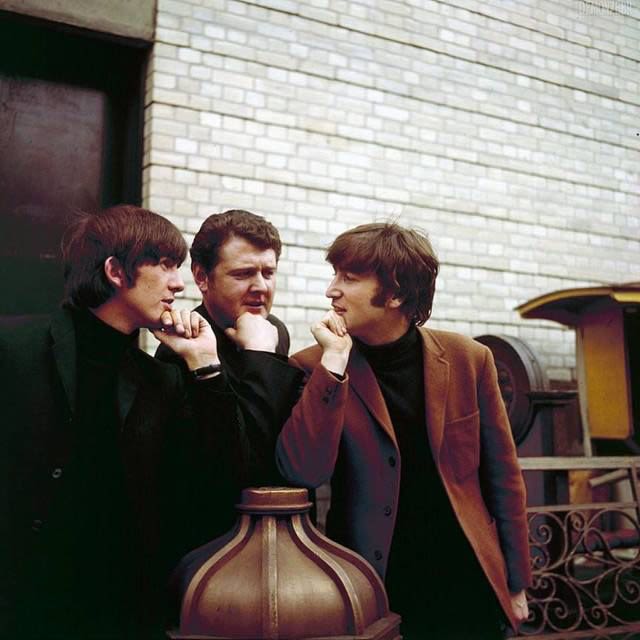
From left to right: George Harrison, Alun Owen, and John Lennon.
From left to right: George Harrison, Alun Owen, and John Lennon.
On-Screen Text
Help! uniquely presents on-screen text narration throughout the film. The result is a humorously serious guide to wild events of the plot. Unlike John Lennon’s verbal narration in Magical Mystery Tour, the narration of Help! is detached and not linked to any Beatle or character. The omniscient third-person quality of the text allows for insertions of Beatle humor and a break in the fourth wall.
Examples of text include, “The exciting adventure of Paul on the floor” when Paul is accidentally shrunk, “A well-known palace” beneath a shot of Buckingham Palace, and the simple “A tiger” accompanying the shot of a tiger threatening Ringo. The mocking tone of the text aids the satirical quality of the film as a whole and interestingly, allows the style of the film to parallel the present day “meme” style of humor.
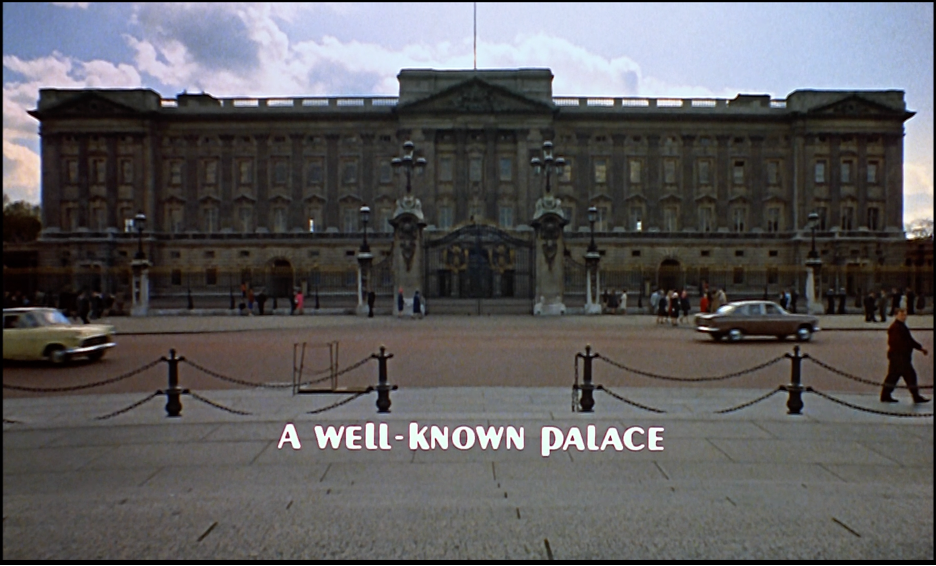
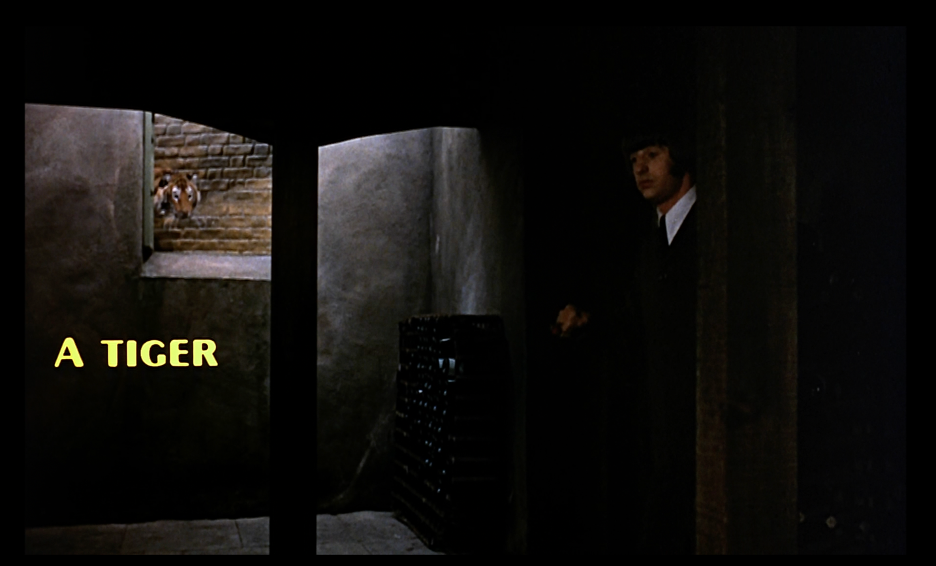
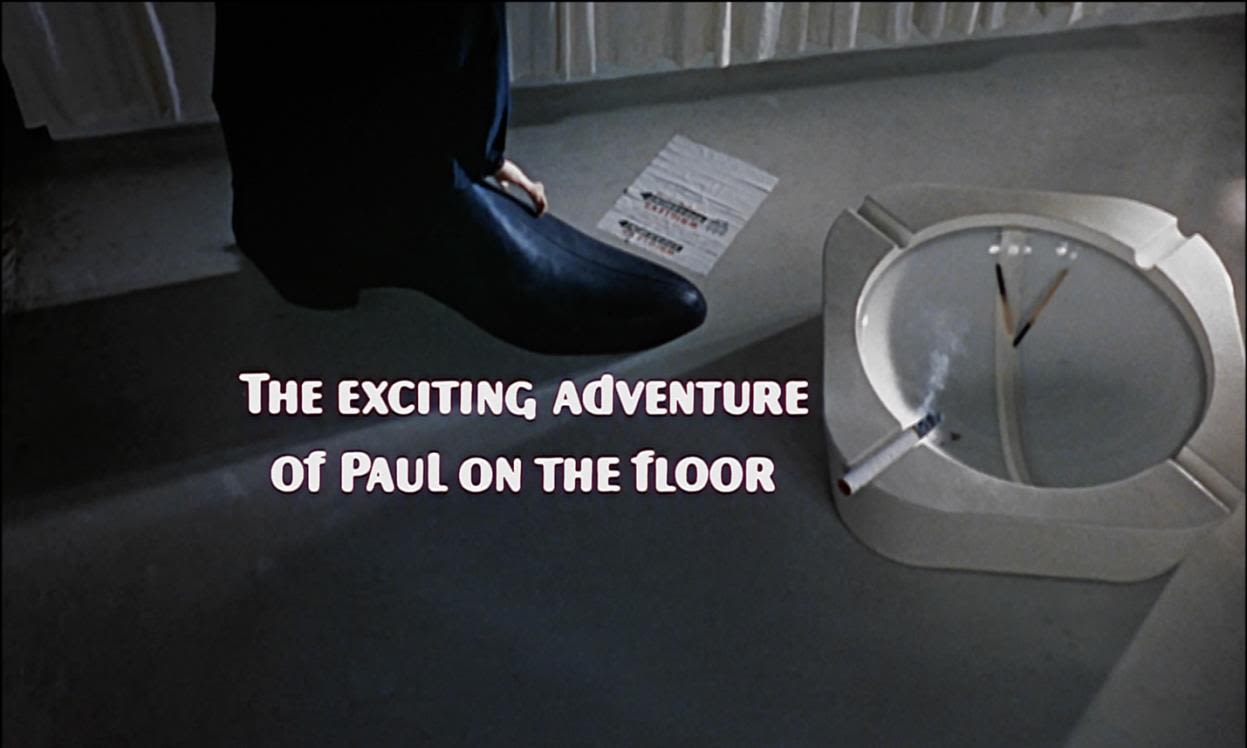

Stylized on-screen text (58:34, Help!).
Stylized on-screen text (58:34, Help!).

Stylized on-screen text (01:06:56, Help!).
Stylized on-screen text (01:06:56, Help!).

Stylized on-screen text (32:56, Help!).
Stylized on-screen text (32:56, Help!).
The Circle
The Beatles themselves receive the writing credit for Magical Mystery Tour mostly because they relied heavily on improvisation. Indeed, the main text document behind the Beatles’ third film is a circle diagram drawn by Paul McCartney. The circle is divided into slices with labels such as “commercial introduction,” “coach people meet each other,” “laboratory sequence,” and “dreams.”
Paul presented this circle as the “script” and described to his fellow Beatles and the crew how the sections would be completed as they filmed. Given the fairly rudimentary, although creative, text structure of Magical Mystery Tour, the visual elements of the multimedia compensate for the text, and the song lyrics receive more importance as the textual element of the film.
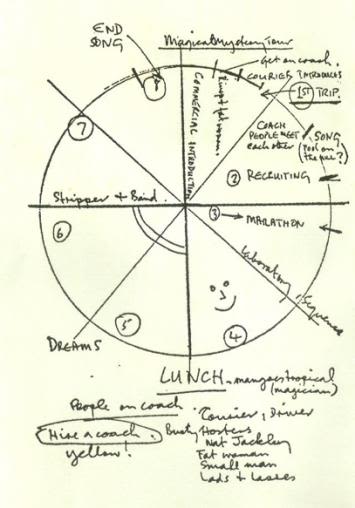
Script of Magical Mystery Tour drawn by Paul McCartney (The Beatles).
Script of Magical Mystery Tour drawn by Paul McCartney (The Beatles).
Visual Stylization
The three Beatles films offer a very diverse representation of the sixties. From the fashion to the locations, the visual element of the multimedia artifacts that are the films work to set the attitude of the time period, the plot, and the Beatles themselves.
Black and White
Dick Lester, the director of A Hard Day’s Night, was initially told the Beatles were a passing craze. They were expected to fade by Fall 1964. Therefore, the film should be shot cheaply in black and white and produced quickly over a few short months. The Beatles have certainly stayed past 1964, but the black and white cinematography offers a timeless quality to the film and the Beatles themselves.
A Hard Day’s Night shows the Beatles in their classic suits. Formal attire was expected of serious bands coming out of the 50s. With black and white obscuring potentially dated color choices, the day in the life of four men in suits stand the test of time. However, in realizing the Beatles’ popularity and creative appeal throughout the filming, the crew behind A Hard Day’s Night also opened the door for popular music cinematography.
Given the time restraints, choices behind close camera angles on guitar strings and cuts between musical performances and traditional life were not overly thought out. However, the energetic improvisation of the film crew complimented the Beatles in their evolving success and comfort on screen. The result was a new style of shooting musical performances and the unique integration of reality with actors playing themselves.
Bond Satire
The Beatles’ 1964 and 1965 careers closely followed the release of several Bond films. Help! began filming just a month after the third James Bond film, Goldfinger, was released in early 1965. The Beatles and Dick Lester were interested in breaking away from A Hard Day’s Night with more action and acting from the Beatles, and thus, a satirical version of the James Bond films was created.
Help! features several traditional Bond film elements with a Beatles’ spin. The Bond theme plays as the cult’s hiding places are revealed and the Beatles escape or fight for their lives. A mysterious woman from the cult works as a “Bond girl” as she helps the Beatles escape from her people in strange hiding locations.
The Beatles engage in a classic Bond-styled wild car chase between scientists and cult members when Ringo is captured in the trunk and George flings himself on the back of the car. In light of 007’s secret agent position, the Beatles turn to governmental agencies for protection and record their songs in a circle of tanks. Overall, Help! is styled as an outrageous action and adventure film; a choice made from the timely influence of the popular Bond series. The stylizing works to present an elaborate version of the Beatles’ lives and a strong contrast to A Hard Days Night.
Psychedelic
Willy Wonka’s Chocolate Factory hardly compares to the world of Magical Mystery Tour. The Beatles jump between their DayGlo yellow bus to the clouds in a wizard laboratory to a surrealist dream sequence. The imaginative and diverse styling of the third film falls into the popular 1962 psychedelia. Several of George Harrison’s personal items appear and represent the colorful styling of the day. As previously mentioned, “Rocky,” George’s Fender Stratocaster received a paint job by George to include trippy DayGlo paint layers and Ohm symbols from his love of mediation.
Additionally, George’s Austin Mini Cooper appears to race the coach bus (which was driven by Ringo). The similarities between the psychedelic styling of his personal car and the Magical Mystery tour bus are uncanny. Surrealism was certainly a strong influence in the styling of the film as well with the absurd designs of the Beatles dressed in classic wizard robes and a visual retelling of John’s dream about shoveling an endless pile of spaghetti.
Interestingly, there have been connections drawn between the visual styling of Magical Mystery Tour and the classic horror film, The Shining. In The Shining, a suit resembling the Walrus costume lurks in the background, the waiter is dressed identically to John in his Magical Mystery Tour dream sequence, and stylistic intermittent cuts to the reactions of a large crowd are presented. All of these strange similarities indicate the potential cinematic influence wielded by Magical Mystery Tour.
Where and How to Watch
Finally, an important part of multimedia today is where and how it can be accessed. All three Beatles films are available as DVD and BluRay copies and can be watched on demand as a part of a personal library or as a rented copy from a public library. This form allows for the films to be watched more than their original releases in cinemas or on television.
From a digital perspective, all three movies can be purchased from Apple TV. However, only A Hard Day’s Night appears for rent across multiple streaming platforms and for free on HBO Max. A Hard Day’s Night has always been the most popular film out of the trio, and given the increased digital access to the movie, the popularity of the debut Beatles movie continues in 2022.
Subtitles are an important textual multimedia component in the viewing experience to allow the films to be more accessible across audiences. A Hard Day’s Night does not provide subtitles within the DVD editions; however, HBO Max may provide subtitles for the film through the streaming service.
The DVD copy of Help! features English, French, Portuguese, Spanish, German, Brazilian Portuguese, Latin American Spanish, Italian, and Dutch subtitles. A music note before the subtitles of the lyrics indicates singing. While sound descriptions of music are not a feature of the subtitles, additional sounds such as a doorbell ring, gasps, whispers, and changes in accents are indicated before text in parenthesizes; for example, “(posh accent)."
Magical Mystery Tour's DVD supports English, French, German, Spanish, Italian, Portuguese, Dutch, Swedish, Norwegian, Scandinavian, and Finnish subtitles. Unlike Help!, subtitles are not present for the lyrics of the songs. Only the visual aid is available but given the lack of total lip-synching across musical performances, Magical Mystery Tour’s musical numbers are limited in their accessibility. In both Help! and Magical Mystery Tour, the text appears in white at the bottom of the screen.
The lack of Beatles movies available digitally is a commentary on the current popularity of the multimedia. The latest DVD copies of the films were all produced from 2007 to 2014, but additional languages and subtitle editing may continue evolve with the possible translation of films to streaming platforms. Given that all three films were released in the 1960s, generations who remember the initial release of the films and Beatles music are an increasingly small primary audience. However, the legacy of the Beatles overall allows for the films to be available online at all in 2022.

Available subtitle languages (Magical Mystery Tour).
Available subtitle languages (Magical Mystery Tour).
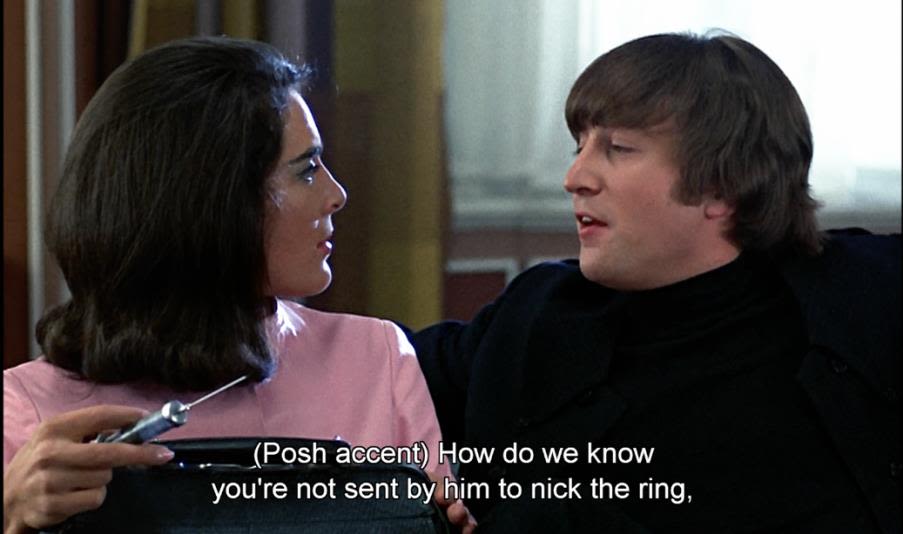
Sample of subtitles (30:12, Help!).
Sample of subtitles (30:12, Help!).
Conclusion
The trio of Beatles films, A Hard Day’s Night, Help!, and Magical Mystery Tour are multimedia artifacts through their audio, text, and visual components. The 1960s films are accessible today in physical copies and digitally, although with limited subtitles, which enables a global audience to continue to enjoy the Beatles’ multimedia.
As the Beatles are an infamous band, music is the foundational element of films. Music is present in the soundtracks and in music video-esq moments. The title tracks of the films bridge the auditory and textual mediums as the storytelling of the Beatles’ album lyrics work in conjunction with or opposition to the plot of the films. The textual element of the multimedia is expanded upon through the structure of a script, emphasis on words on screen, and written creative process behind the films. To compliment auditory and textual medias, each film’s unique and influential cinematography reflects the historical time period and personal interests of the Beatles through visual stylization.
The films are a revolutionary example of multimedia in their ability to build on popular music and musicians in a larger creative context with the addition of textual and visual elements. Ultimately, the Beatles’ films uniquely straddle the music world and cinematic world in their multimedia form and work to holistically compliment the creative goals and talents of the Beatles.
